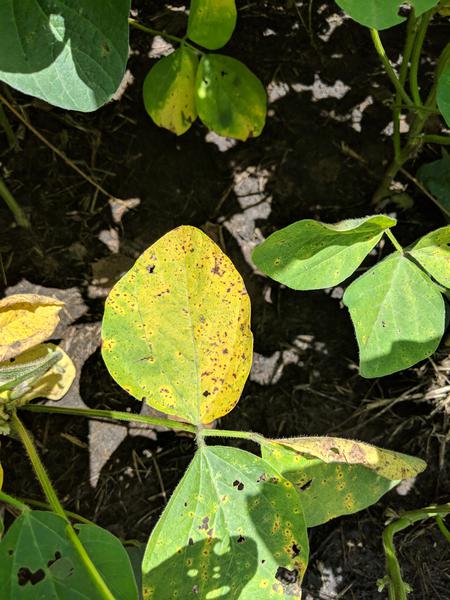Brown Spot
- Scientific Name(s)
- Septoria glycines
- Type
- Disease
- Leaf Condition
- Leaf Spot
- Leaf Color
- Black Irregular Spots, Patchy Yellow And Brown Areas
- Leaf Location
- Entire, Lower, Young, Mature
- Pod Condition
- Lesion
- Main Stem
- Necrotic Spots
- Petioles Condition
- Lesion
- Field Distribution
- Random, Low Areas, Localized Area
- Prior Environmental
- Rain, Thunderstorm, Cool Cloudy
- Season
- Early Vegetative, Mid To Late Vegetative, Flowering, Pods Present
- Cropping System
- Soybean Followed By Soybean, Conventional Till, Reduced Till
Introduction
Soybean brown spot, also known as septoria brown spot, is caused by the fungal pathogen Septoria glycines. Infection causes irregular brown patches of dead tissue on leaves, and causes defoliation in severe cases. While often a minor disease with little impact on yield, the combination of susceptible variety and environmental conditions favorable to disease can result in significant losses. From the years 2003 to 2005, soybean losses in North Carolina due to brown spot ranged from 1.3% to 4.7%. Losses in individual fields can be as high as 8%, though observations of higher losses have been reported.
Pathogen
Septoria glycines is one of the many fungal pathogens that cause necrotic spots on leaves of soybean. The disease is spread as asexual spores (conidia) via wind and water to leaves. Under conducive conditions, including warm temperatures and high humidity, the spores germinate and infect the leaf tissue. Infection usually begins in the lower and middle canopy and may progress upward. The fungus survives on infected soybean tissues that are left in the field after harvest, and spores are released the following growing season when warm, wet conditions are present.
Host Range
The host range of Septoria glycines includes other legume species and common weeds.
Symptoms
Symptoms include light to dark brown necrotic regions on the lower leaves of the plant, often with chlorosis surrounding the necrotic region. As the spots progress they become irregular in shape and leaf yellowing will expand far beyond the necrotic region. Defoliation of the lower and middle canopy can occur in severe cases.
Diseases With Similar Symptoms
Bacterial blight (Pseudomonas syringae pv. glycinea). Bacterial blight lesions tend to remain small and multiply across the leaf surface with the chlorosis spreading only a short distance from the spots, and no fungal signs are present in the lesions.
Disease Cycle and Favorable Conditions for Disease
Septoria brown spot overwinters as spores in plant debris left in the field. Heavy rains and wind carry the spores to the lower canopy of the plant. Spores that land on a susceptible host geminate and infect leaf tissue. S. glycines requires moisture to grow, and spreads rapidly under warm, humid conditions. Hot, dry weather limits disease growth and development of the brown spot pathogen. Under conducive conditions, the disease will spread rapidly upward through the plant, eventually causing defoliation of the plant. Following harvest, the fungus remains in the field on crop debris left behind and overwinters until conducive conditions are present.
Management
Since the disease overwinters in crop residue, destroying crop debris is an important control method for continuously cropped soybean fields. Tillage practices that favor rapid breakdown of crop residues are also beneficial to limiting losses from disease.
Crop rotation to non-host crops may also help to reduce inoculum build up in the field. Common rotational crops like corn and cotton are non-hosts.
Fungicides are often not needed to manage brown spot in North Carolina; however, brown spot damages may require their use when conditions are conducive for development (e.g. significant rain events, hurricanes). Fungicides applied between R3 and R5 provide the most impact on yield. In 2019, FRAC added S. Glycines to the list of diseases with medium risk of developing resistance. If multiple fungicide applications are needed, selecting fungicides with different modes of action is important to limit fungicide resistance development. For fungicide efficacy, see the Soybean Fungicide Efficacy Tables.
Useful Resources
Crop Protection Network factsheet for Brown Spot has information on the pathogen and the disease epidemic.
- The NC State University Plant Disease and Insect Clinic provides diagnostics and control recommendations.
- The NC State Extension Plant Pathology portal provides information on crop disease management
- The North Carolina Agricultural Chemicals Manual provides pesticide information for common diseases of North Carolina. The manual recommendations do not replace those described on the pesticide label, and the label must be followed.
Acknowledgements
This factsheet was prepared by the NC State University Field Crops and Tobacco Pathology Lab in 2020.
- Check out our Facebook and our Twitter!



